The introduction of the Markets in Crypto-Assets Regulation (MiCA) by the European Union marks a significant step in regulating the cryptocurrency market. These new regulations aim to make the market more transparent, secure, and stable. Specifically for crypto exchanges, MiCA brings specific requirements and compliance audits essential for meeting legal standards.
New Rules for Crypto Exchanges
1. Licensing and Registration:
Crypto exchanges operating in the EU must obtain a license from the relevant national authorities. The licensing requirements include:
- Financial Reserves: Proof of sufficient financial resources to ensure smooth operations and cover potential risks.
- Security Standards: Implementation of robust security protocols to protect the exchange and customer assets from cyberattacks.
2. Transaction Monitoring and Compliance:
- AML/KYC Processes: Crypto exchanges must adhere to strict Anti-Money Laundering (AML) and Know-Your-Customer (KYC) requirements. This involves verifying the identity of all users and continuously monitoring transactions to prevent illegal activities.
- Transparency: Exchanges are required to maintain detailed records of all transactions and make them available to regulatory authorities upon request.
3. Investor Protection:
- Safeguards: Exchanges must implement mechanisms to protect investor funds, including securing customer assets and establishing compensation funds in case of losses due to fraud or insolvency.
- Educational Initiatives: Crypto exchanges must provide educational resources to enhance investors’ understanding of cryptocurrencies and their associated risks.
Compliance Audits
MiCA also introduces regular compliance audits for crypto exchanges to ensure adherence to the regulations. These audits include:
1. Regular Reviews:
- Internal and External Audits: Crypto exchanges must conduct both internal and external audits to verify their processes and systems comply with MiCA regulations.
- Reporting: The results of these audits must be submitted to national regulatory authorities, who will verify the exchanges’ compliance with legal requirements.
2. Monitoring AML/KYC Processes:
- Continuous Monitoring: Compliance with AML/KYC regulations is ensured through continuous monitoring and regular reviews.
- Reporting Suspicious Activities: Exchanges must report suspicious activities and take measures to prevent money laundering and terrorism financing.
3. Security Assessments:
- Cybersecurity Audits: Regular security assessments and penetration tests are required to ensure that the exchanges’ security protocols are effective and can withstand current threats.
- Data Protection: Compliance with data protection regulations is also reviewed to ensure the protection of customers’ personal data.
4. Financial Reporting:
- Transparent Reporting: Crypto exchanges must regularly produce financial reports disclosing their financial condition, performance, and all relevant financial transactions.
- Auditor Verification: These reports must be verified by independent auditors to ensure their accuracy and completeness.
Conclusion
The new rules and compliance audits under the MiCA regulation ensure that crypto exchanges in the EU are strictly monitored and regulated. This helps strengthen investor confidence, stabilize the market, and prevent illegal activities. For crypto exchanges, this means adapting their internal processes and systems to meet the new requirements to continue operating in the market. In the long term, however, the new regulations also offer opportunities by contributing to a more transparent and secure market environment that fosters the growth and acceptance of cryptocurrencies.
